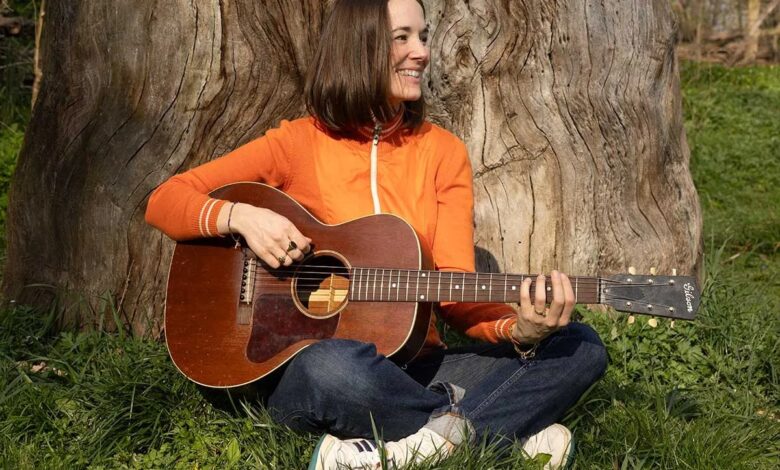Margaret Glaspy Connects with Her Younger Self—and an Old Gibson L-00—on ‘The Sun Doesn’t Think’

Near the beginning of the video to her recent song “Act Natural,” singer and songwriter Margaret Glaspy appears to pull off the impossible feat of changing instruments as often as every beat, cycling through a Danocaster, Rickenbacker, Teisco, National, and others in dizzying sequence. It feels like a celebration of the electric guitar, and, come to think of it, so too does Glaspy’s work in general. Many of her tunes put the instrument in the foreground, with finely crafted riffs that feel spontaneous and transgressive—all at the service of the song.
At the same time, Glaspy has a deep and authentic connection to the acoustic world. The Northern California native, now 35, grew up playing the fiddle and performing regularly in the National Oldtime Fiddlers’ Contest and Festival before switching to guitar and songwriting. Many of the rock band and synth-driven songs on her three captivating solo albums—Emotions and Math (2016), Devotion (2020), and Echo the Diamond (2023)—originated on the acoustic guitar. And Glaspy has hinted at her acoustic side in recent years, whether playing a cover of Sade’s “By Your Side” on her Collings OM1A JL in a pandemic video from home, or her song “Turn the Engine” on her Waterloo WL-14 in an informal performance she filmed for Fretboard Journal.
But it wasn’t until a recent solo acoustic tour that Glaspy played for a public audience with just her steel-string guitar for the first time in her professional life, a format she found freeing both literally and metaphorically. And while touring, she wrote a fresh set of songs, which she recorded in an informal solo acoustic setting with a minimum of takes for her most recent EP, The Sun Doesn’t Think.
I chatted with Glaspy via Zoom from her home in New York. Among other things, she discussed her recent experiences in going unplugged; what it was like to connect with her younger self in writing new songs; taking over a prized vintage Gibson scored by her husband, jazz guitarist and composer Julian Lage; and more.

It’s been wonderful to hear you in acoustic settings recently. After years of performing and recording with bands, why did you decide to do a solo tour and EP?
There was a necessity on my end. I often play acoustic guitar at home; that is the kind of environment that I find synonymous with the acoustic guitar. Because I’m often traveling with gear and schlepping things around, I also find acoustic guitar to be synonymous with this feeling of unfettered ease: You walk in with your case, walk out, and that’s it. I really craved to be able to do that.
Having an offering that felt substantial was a challenge. I just wanted to know that I could play music and have it be an utterly simple transaction. Not to say that my electric show isn’t simple—it’s one of the most pared-down bands, a trio—and there are very little effects. Just to walk in and put the songs in the forefront [in an acoustic show] was really fun. It matched my expectations of feeling this kind of catharsis in being able to do something simple but very meaningful.
While you’ve recorded most of your songs with an electric band, they’re durable and lend themselves naturally to other settings. This was especially evident when I saw you performing earlier this year at SFJazz with Rude Ruth—for that particular show, an improvising band with Julian Lage on guitar. Is that an intentional part of your songwriting process?
Thank you—that’s a really cool compliment. Julian calls me a completist in that to get one thing done, I have to get a lot of other things done. That’s all part of my process to feel like I am giving something robust, an emotional as well as musical offering. It would be a total success to me if the songs can thrive in a lot of different environments. And I think that comes from all my musical mentors—whether my friends, my husband, or the musicians I’ve grown up with, it feels like it’s all in my DNA now.
What have you taken from the acoustic world, and what’s it been like to reconnect with it?
I grew up in the acoustic world—I was a fiddle player when I was young—and it taught me that you can make music here and now, unfettered and unplugged, and it can be very complete. When I play an electric show, it’s loud and boisterous in its own way. It feels extreme, because the ground and the ceiling might be different for me than the next singer-songwriter. For me, acoustic music is the floor, and anything up from there is intense and exploratory.

In returning to the acoustic guitar, there’s a feeling of pushing my own boundaries. And in exploring the acoustic guitar onstage, there’s a reminder of how acoustic functions apart from electric. You would think that electric would be the most volatile instrument you could find. But really, acoustic guitar has all these wild and woolly aspects that are challenging and fun to play with. There’s an intensity to it that I find arresting.
You mentioned your husband as a mentor. How does his influence show up in your music? And what’s it been like to witness and support each other’s musical development for many years now?
We’ve been there for one another, making music together on the sidelines of one another’s projects for a really long time, so it’s second nature. There’s no doubt that Julian has such a big influence on my music. He’s not a lyrics-first kind of musician, and so when he does hear lyrics, it’s an interesting barometer. If a lyrical concept that I’ve written captures his attention, then I consider it to be unique, because that’s not always his first takeaway.
In musical collaborations with your partner, there can be too much pressure on that person to be honest with you, but it’s really cool to have such an open dialogue. Nothing goes untouched by one another’s ears and eyes and sense of what could be interesting. It’s a total collaboration. We just dive headfirst into it, and that’s how we roll. There’s a sense of trust with one another, and an understanding that we’re artists, and this is what we do.
On social media you posted that writing “The Sun Doesn’t Think” involved “a lot of tears and time spent courting pain and sunshine all at once.” Is that true of the EP on the whole?
Not really. There are aspects that are character-driven. A song like “Would You Be My Man?” feels like it was written on behalf of someone else in some way, shape, or form—as opposed to “The Sun Doesn’t Think,” which feels very much like my story. I’m starting to dabble in more narrative stuff. There are some songs on that EP that are right out of my heart, and others feel like they’re out of someone else’s life that has dropped in lately. So it’s a mix.
You also wrote that working on the project was an attempt to explore your childhood beliefs. What made you want to do that?
It was just kind of time of life. I’m 35 years old, metabolizing where I’m at and seeing that if you’re still experiencing life through the eyes of the child as an adult, then no wonder it feels a little wonky. I’m starting to see that I still feel very endeared to mentalities about love and how to get it, life and how to live it—all through the eyes of a five-year-old child. I’ve never really updated the software. But I also feel really liberated in being an adult. I’ve become the most myself, rather than losing myself somehow. That has been a really cool thing for me to lean into as an artist.

The guitar parts on the EP are interesting in that many are deceptively straightforward. The right-hand patterns might seem familiar, but a song like “Would You Be My Man?” [Example 1], for instance, has some unpredictable rhythms in the bottom register. Are those sorts of manipulations deliberate on your part, or just how you feel and hear things?
I think it’s a little bit of both. One is that because I’m often playing and writing by myself, things will come out that I think feel normal and are just kind of within my own wheelhouse. And then in playing them with someone else, I notice things I didn’t realize I had done—things that came about by letting the lyrics lead and accommodating them. So, some of the parts are a little wonky in their own way because that’s how I heard them, and other times they start out more normal, and then in editing them, things get changed.
Your songs tend to have efficient harmonic movement. In writing parts like the intro to “24/7” [Example 2] or “Bathtub” [Example 3], are you consciously thinking about smooth voice leading and maintaining common tones between chords?
There’s an effort to make things feel like they’re always very close to one another. I feel a little bit allergic to having large jumps—I want it to creep. I wouldn’t ever seek chordal information up the neck if I’m already playing down at the bottom.
I remember being fascinated with Bach chorales, studying voice leading and basic contrapuntal movement, and getting that in my blood to see how I could employ that on the guitar. I think about it a lot, not when I’m writing the songs, but after they are written when I finesse things a bit. It’s not totally by happenstance, in terms of the actual voice leading. I like that work, for sure; I like to get in there and fiddle with the bits.
And it shows… The guitar on the EP has a warm and detailed sound. What were you playing?
It’s a 1932 Gibson L-00. Julian got it, and then I totally took it over. I love it very much. Between Gibson and Martin, I lean to the Gibson side, which feels a little warmer, darker, and rounder, while the Martin side is more precise. With a Gibson, it feels like there’s a little sheen or filter on it—like you have another guitarist playing with you—that I appreciate, especially for solo playing. It has a character of its own, has something to offer, and it’s going to stand its ground. I love that Gibson because it feels there’s like a relationship and a chemistry between me and the guitar.




